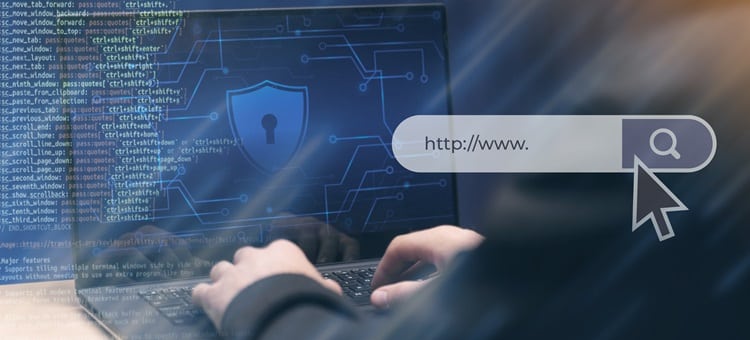In the digital era, where the internet is a central pillar of our daily lives, the importance of cybersecurity in modern web design has never been more crucial.
Websites are not just digital storefronts or platforms for content; they are vital assets that require robust protection. As the first line of defense against an ever-evolving landscape of cyber threats, a well-designed website must integrate security at its core.
From small businesses to large corporations, the risks of overlooking cybersecurity can lead to severe consequences, including data breaches, financial losses, and damaged reputations.
This article delves into the essentials of crafting cybersecure websites, a necessity in modern web design. We’ll explore common cybersecurity threats websites face today, such as hacking attempts, phishing schemes, malware infections, and DDoS attacks.
Each poses a unique challenge, requiring web designers and developers to be vigilant and proactive in their approach to website security. Understanding these threats and implementing strategic defenses can create aesthetically pleasing, resilient, and secure online spaces.
Understanding the Cybersecurity Landscape
To craft cyber secure websites, it’s essential to understand the various cyber threats lurking in the digital space. Among the most prevalent are:
- Hacking: This involves unauthorized access to website data, often leading to theft of sensitive information or sabotaging the website’s functionality.
- Phishing: A deceptive practice where attackers trick users into revealing personal or financial information by masquerading as a trustworthy entity in digital communication.
- Malware: Short for malicious software, malware includes viruses, worms, and trojans, which can damage systems, steal data, or take control of website operations.
Each of these threats can exploit different vulnerabilities in a website, necessitating a multi-faceted approach to web security.
Impact On Businesses
The statistics surrounding cyberattacks highlight their significant impact on businesses. According to recent reports:
- A staggering percentage of small businesses have experienced a cyber-attack, emphasizing that no company is too small to be targeted.
- The average data breach cost for businesses can run into millions, accounting for immediate financial losses and long-term reputational damage.
- Downtime caused by cyber-attacks, especially for e-commerce websites, can lead to substantial revenue losses and erode customer trust.
These figures underscore the critical need for robust cybersecurity measures from a modern web design agency. By understanding the types of threats and their potential impacts, businesses and web designers can better prepare and protect themselves against the ever-evolving landscape of cyber risks.
Fundamentals of Cybersecure Web Design
To effectively safeguard websites against the myriad of online threats, understanding and implementing the fundamentals of cybersecure web design and having support from IT help desk companies are crucial.
This not only helps in protecting sensitive data but also ensures a trustworthy user experience. Key among these fundamentals are:
- Secure Coding Practices:
The foundation of a secure website lies in its code. Adhering to secure coding practices involves writing code that is not only functional but also resistant to various forms of attacks.
This includes validating user inputs to prevent SQL injection, ensuring secure session management, and protecting against cross-site scripting (XSS) attacks. Regular code reviews and employing automated tools for vulnerability scanning are also vital in maintaining a secure codebase. - Importance of Responsive Design for Security:
Responsive design isn’t just about visual appeal and user experience; it also plays a significant role in security. A responsive website adapts to different devices and screen sizes, reducing the risk of security vulnerabilities arising from device-specific code.
This adaptability also ensures that security measures are consistently implemented across all devices, minimizing potential weak points that hackers could exploit. - The Role of HTTPS and SSL Certificates:
Secure HyperText Transfer Protocol (HTTPS) and Secure Sockets Layer (SSL) certificates are no longer just optional add-ons but necessities for modern websites.
HTTPS, indicated by a padlock symbol in the browser’s address bar, ensures that the data transferred between a website and its users is encrypted and secure. SSL certificates authenticate a website’s identity, adding a layer of trust. This is particularly crucial for e-commerce sites and websites that handle sensitive user data.
Incorporating these fundamentals into web design enhances security and fosters trust among users, an invaluable asset in the digital age.
Key Elements of a Cybersecure Website
Creating a cyber secure website involves integrating several key elements to safeguard user data and the website’s integrity. These elements are fundamental in building a robust defense against various cyber threats.
- Strong Authentication and Access Control:
A critical aspect of website security is ensuring that only authorized individuals can access sensitive areas or data. Strong authentication methods, like two-factor authentication (2FA) and complex password policies, significantly reduce the risk of unauthorized access. Equally important is stringent access control, ensuring users can only access the data and features necessary for their role, minimizing the potential damage in case of account compromise. - Data Encryption Methods:
Encrypting data is essential in protecting sensitive information in transit and at rest. Encryption methods, such as Transport Layer Security (TLS) for data in transit and advanced encryption standards for data at rest, ensure that even if data is intercepted or accessed by unauthorized parties, it remains undecipherable and secure. - Regular Updates and Patches:
Cyber threats are constantly evolving, and so should the defenses of a website. Regularly updating and patching the website’s software, including its content management system (CMS), plugins, and third-party integrations, is crucial in fixing security vulnerabilities that attackers could exploit. A schedule for regular updates and monitoring for new patches plays a key role in maintaining a secure website. - Secure Payment Gateways:
For e-commerce websites, securing payment transactions is paramount. Integrating secure payment gateways that comply with industry standards like PCI DSS (Payment Card Industry Data Security Standard) helps protect sensitive financial data. Additionally, using well-established payment processors with robust security measures adds an extra layer of trust and security for the business and its customers.
Integrating Security in the User Experience
A key challenge in modern web design is integrating robust security measures while maintaining a user-friendly experience. This delicate balance is essential for protecting users and ensuring they remain engaged and satisfied with the website.
- Balancing Security with User-Friendliness:
The goal is to implement security protocols that are effective yet unobtrusive. For instance, while strong password requirements enhance security, they can frustrate users if they are too complex.
Solutions like offering a password strength meter can encourage secure practices without diminishing user experience. Similarly, streamlining two-factor authentication processes using SMS or authentication apps can offer robust security without significantly impeding the user flow. - Educating Users on Secure Practices:
A critical but often overlooked aspect of cybersecurity is user education. Incorporating tooltips, informative messages, and guidance within the website can help users understand the importance of security measures, like why they need to verify their email or use two-factor authentication.
Websites can foster a culture of security awareness and participation by educating users non-intrusively. - Designing for Privacy and Data Protection:
In an age where data privacy concerns are paramount, designing with privacy in mind is not just a legal obligation but a trust-building measure. This includes transparent data collection policies, clear opt-in and opt-out options for data sharing, and ensuring that privacy settings are easy to find and adjust.
Providing users control over their data not only complies with regulations like GDPR but also enhances the overall perception of the website as secure and user-centric.
Utilizing Security Tools and Resources
A robust cybersecurity strategy for a website involves a suite of tools and resources designed to protect against a wide range of threats. Understanding and implementing these tools is crucial in fortifying a website’s defenses.
- Overview Of Essential Security Tools:
The first line of defense in website security includes tools like firewalls and anti-malware software. Firewalls act as gatekeepers, controlling incoming and outgoing network traffic based on predetermined security rules, thus protecting the website from unauthorized access and attacks.
On the other hand, anti-malware software helps detect, prevent, and remove malicious software that could compromise website integrity and user data. - Importance Of Regular Security Audits:
Regular security audits are essential to ensure that all security measures are effective and up-to-date. These audits involve a comprehensive examination of the website to identify vulnerabilities and potential security gaps.
Regularly assessing the website’s security posture can address issues before attackers exploit them. This proactive approach is critical in maintaining a secure and resilient online presence. - Using Web Application Firewalls (WAFs):
Web Application Firewalls (WAFs) provide a more specialized form of protection, particularly against web application attacks such as SQL injection, cross-site scripting (XSS), and session hijacking.
A WAF filters, monitors, and blocks malicious traffic to and from a web application, providing an additional layer of security. Implementing a WAF is particularly important for websites that handle sensitive data, as it adds an extra security layer between the website and the end user.
Best Practices in Web Development for Enhancing Security
Implementing best practices in web development is crucial to fortify websites against cyber threats. These practices strengthen a website’s security and ensure that security is an integral part of the development process.
- Secure Development Lifecycle (SDLC):
Integrating security into the Software Development Lifecycle (SDLC) is fundamental. This approach means considering security at every stage of development, from planning and design to deployment and maintenance.
By doing so, security becomes a continuous process, allowing developers to identify and mitigate risks early in the development cycle. It involves practices like threat modeling, secure coding guidelines, and security testing as an integral part of the development process. - Regular Code Reviews And Vulnerability Assessments:
Regular code reviews are essential for maintaining a high-security standard. These reviews, conducted by peers or automated tools, help identify security flaws and areas for improvement in the codebase.
Coupled with vulnerability assessments, which involve scanning the website for known vulnerabilities, these practices ensure that potential security issues are identified and addressed promptly. This ongoing evaluation process is crucial in adapting to new threats and maintaining the website’s integrity. - Implementing Content Security Policy (CSP):
Content Security Policy (CSP) is a powerful tool for preventing certain types of attacks, including Cross-Site Scripting (XSS) and data injection attacks. CSP specifies which sources the browser should trust for executable scripts, stylesheets, and other content.
By controlling the resources, the website can load and execute, CSP significantly reduces the risk of malicious content compromising the website. Implementing CSP effectively can be challenging, but it’s a vital step in securing a modern website.
Future Trends in Cybersecurity for Web Design
As technology evolves, so does the landscape of cybersecurity. Staying ahead in web design means understanding current security practices and anticipating future trends and challenges. Here are some key areas of focus:
- Emerging Technologies and their Implications:
Emerging technologies like artificial intelligence (AI) and blockchain are set to impact web security significantly. AI can be leveraged for advanced threat detection and automated response systems, enhancing real-time protection against cyber-attacks.
AI algorithms can analyze vast amounts of data to identify potential threats more quickly and accurately. On the other hand, blockchain technology offers new ways to secure transactions and data integrity, providing a decentralized and tamper-proof system.
Its application in areas like identity verification and secure data storage is poised to transform web security paradigms. - The Evolving Landscape of Cyber Threats:
Cyber threats are becoming more sophisticated, with attackers using advanced techniques like AI and machine learning to bypass security measures. Phishing attacks, for instance, are becoming more targeted, and ransomware is evolving to be more destructive.
Web designers and developers must be prepared for these threats by staying updated with the latest security trends and threats and continuously updating their security strategies. - Preparing for Future Challenges in Web Security:
To prepare for these future challenges, web designers must adopt a proactive and adaptive approach to security. This involves keeping abreast of the latest developments in cybersecurity and continuously updating and testing web security measures.
Investing in ongoing education and training in new security technologies and methodologies will be key. Additionally, considering security in the early stages of design and development will become increasingly important to build inherently secure websites.
Conclusion
Crafting cybersecure websites in the modern web design landscape is an intricate balance of implementing secure coding practices, employing robust security tools, and staying abreast of evolving cybersecurity threats.
As we’ve explored, integrating strong authentication mechanisms, regular security audits, and emerging technologies like AI and blockchain are pivotal in fortifying web defenses. The importance of continuous learning and adaptation in the face of ever-changing cyber threats cannot be overstated.
For web designers and developers, this means an ongoing commitment to prioritizing cybersecurity, not only as a design component but as a fundamental aspect of user trust and experience. By embracing these principles and practices, we can create visually compelling but also secure and resilient online environments.







